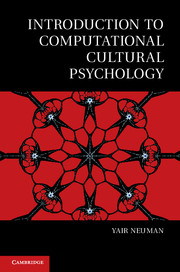Book contents
- Frontmatter
- Dedication
- Contents
- List of Figures
- List of Tables
- Preface
- Acknowledgments
- 1 What is computational cultural psychology?
- 2 The digital psychologist: information technology and cultural psychology
- 3 Why don’t primates have God? Language and the abstraction of thought
- 4 Lost in translation: how to use automatic translation machines for understanding “otherness”
- 5 Spies and metaphors: automatic identification of metaphors for strategic intelligence
- 6 Scent of a woman: the mediation of smell and automatic analysis of extended senses
- 7 Dolly Parton’s love lexicon: detection of motifs in cultural texts
- 8 The relational matrix of the I
- 9 Identifying themes: from the Wingfield family to Harry and Sally
- 10 Eating and dining: studying the dynamics of dinner
- 11 Getting even: the cultural psychology of revenge and what computers can do about it
- Epilogue: on generals and mail coach drivers
- Bibliography
- Author index
- Subject index
4 - Lost in translation: how to use automatic translation machines for understanding “otherness”
Published online by Cambridge University Press: 05 June 2014
- Frontmatter
- Dedication
- Contents
- List of Figures
- List of Tables
- Preface
- Acknowledgments
- 1 What is computational cultural psychology?
- 2 The digital psychologist: information technology and cultural psychology
- 3 Why don’t primates have God? Language and the abstraction of thought
- 4 Lost in translation: how to use automatic translation machines for understanding “otherness”
- 5 Spies and metaphors: automatic identification of metaphors for strategic intelligence
- 6 Scent of a woman: the mediation of smell and automatic analysis of extended senses
- 7 Dolly Parton’s love lexicon: detection of motifs in cultural texts
- 8 The relational matrix of the I
- 9 Identifying themes: from the Wingfield family to Harry and Sally
- 10 Eating and dining: studying the dynamics of dinner
- 11 Getting even: the cultural psychology of revenge and what computers can do about it
- Epilogue: on generals and mail coach drivers
- Bibliography
- Author index
- Subject index
Summary
Abraham Wald (1902–1960) was an Austro-Hungarian-born Jew. As a Jew raised in a religious family he couldn’t attend school on Saturday and therefore was homeschooled by his parents. This homeschooling was extremely successful as Wald graduated from the University of Vienna with a Ph.D. in mathematics. Wald was forced to flee to the USA when the Nazis came into power and developed his academic career in that welcoming country.
In retrospect, the Nazis’ “thesis” of the Aryan race’s superiority over the Jews was powerfully refuted when Jewish scientists, such as those who led the Manhattan Project, became the cutting edge of the war efforts. We could not imagine the war efforts of the USA without Robert Oppenheimer, Edward Teller, John von Neumann, and many others.
During the Second World War, Wald made his own personal contribution to the war efforts (Mangel and Samaniego 1984 ). The context of his contribution is extremely interesting. The American airplanes that returned from the front were, naturally, damaged by antiaircrat artillery. As a solution the army sought to add armor to the planes. However, covering the whole airplane’s belly and wings with armor would necessarily result in a weight increase that would have fatal consequences. Therefore, as a commonsensical solution, the army considered adding armor only to areas that statistically showed the most damage.
- Type
- Chapter
- Information
- Introduction to Computational Cultural Psychology , pp. 57 - 77Publisher: Cambridge University PressPrint publication year: 2014



